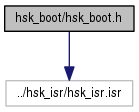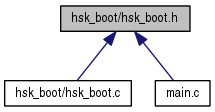|
hsk_libs-dev
163:b63ae088cc97
High Speed Karlsruhe XC878 library collection
|
|
hsk_libs-dev
163:b63ae088cc97
High Speed Karlsruhe XC878 library collection
|
HSK Boot headers. More...
#include "../hsk_isr/hsk_isr.isr"

Go to the source code of this file.
Functions | |
| void | hsk_boot_extClock (const ulong clk) |
| Switches to an external oscilator. More... | |
HSK Boot headers.
This file contains the prototypes to put the µC into working condition.
Currently implemented:
Linking this library also automatically causes the following boot actions:
| void hsk_boot_extClock | ( | const ulong | clk | ) |
Switches to an external oscilator.
This function requires xdata access.
The implemented process is named: "Select the External Oscillator as PLL input source"
The following is described in more detail in chapter 7.3 of the XC878 User Manual.
The XC878 can either use an internal 4MHz oscilator (default) or an external oscilator from 2 to 20MHz, normally referred to as FOSC. A phase-locked loop (PLL) converts it to a faster internal speed FSYS, 144MHz by default.
This implementation is currently limited to oscilators from 2MHz to 20MHz in 1MHz intervals.
The oscilator frequency is vital for external communication (e.g. CAN) and timer/counter speeds.
This implementation switches to an external clock ensuring that the PLL generates a 144MHz FSYS clock. The CLKREL divisor set to 6 generates the fast clock (FCLK) that runs at 48MHz. The remaining clocks, i.e. peripheral (PCLK), CPU (SCLK, CCLK), have a fixed divisor by 2, so they run at 24MHz.
After setting up the PLL, this function will register an ISR, that will attempt to reactivate the external oscillator in a PLL loss-of-clock event.
| clk | The frequency of the external oscilator in Hz. |
WARNING - Here be dragons ...
Before messing with this stuff you should be aware that this is tricky business. Mistakes can result in hardware damage. Or at least all your timers and external interfaces will act weird.
Basically this bypasses/turns off the PLL, sets up the external oscilator and than reconfigures the PLL and brings it back into play.
Many of the OSC_CON, which is on page 1, bits are write protected. The MAIN_vUnlockProtecReg() turns the protection off for 32 cycles. So it has to be turned off each time protected bits are accessed.
